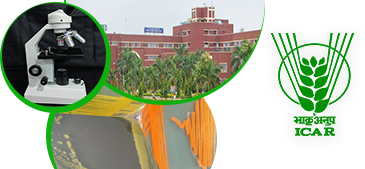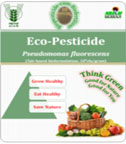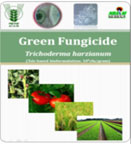Navigation
Technologies Developed
Microbial Diagnostics
A. Diagnostic marker for Fusarium: PCR based diagnostic markers for Fusarium based on exopolygalacturonase (Pgx), intergenic spacer (IGS) and alcohol dehydrogenase (ADH) genes have been detected for specific detection of Fusarium
B. Diagnostic marker for Alternaria: A new diagnostic marker based on noxB gene has been developed and validated for early and specific detection of Alternaria spp. in different crop species.
C. LAMP assays for rapid and specific detection of Rhizoctonia solani: A colorimetric LAMP assay using Polygalacturonase gene has been standardized for detection of Rhizoctonia solani AG-1 from plant tissue as well as from soil
Bioformulations
A. For nutrient management
1. BioNPK
Bio NPK Liquid Biofertilizer is a unique kind of bioformulation comprising nitrogen (N2) fixing (Azotobacter sp.), P-solubilizing (Paenibacillus sp.) and K-solubilizing (Bacillus sp.) bacteria. It has a longer shelf life (12 – 24 months) without loss of microbial populations and properties upon exposure to high temperature.
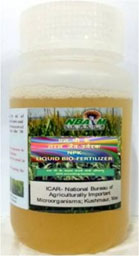 Target crops and delivery system: BioNPK can be used for cereals, millets, pulses, vegetables and oil producing commercial crops. Inoculation can be done through seed treatment, root dip for seedlings and soil application for tree plants.
Target crops and delivery system: BioNPK can be used for cereals, millets, pulses, vegetables and oil producing commercial crops. Inoculation can be done through seed treatment, root dip for seedlings and soil application for tree plants.
Target agroecological zones (if any): All
Validation and commercialization: The technology has been validated for Maize at multiple locations under AICRP, for fodder crops at ICAR-IGFRI, Jhansi, for groundnut at multiple locations under AICRP (groundnut); for Wheat at ICAR- IARI and ICAR-NBAIM, Mau and under farmer’s field for rice and wheat. In addition the technology has given good results in citrus orchards (in Punjab), papaya (Begusarai, Bihar), ginger and turmeric (Anand, Gujarat). Technology is registered with Agrinnovate Pvt Ltd.
2. BIOGROW
 BIOGROW’ has been developed using consortium of different bacterial species endowed with phosphorus solubilization, IAA and siderophore production attributes.
BIOGROW’ has been developed using consortium of different bacterial species endowed with phosphorus solubilization, IAA and siderophore production attributes.
Target crops and delivery system: BioGrow can be used for vegetable crops particularly solanaceous crops like tomato, brinjal, potato; and for floriculture crops.
Target agroecological zones (if any): All
Validation and commercialization: Validated on tomato, potato and marigold at different locations in Mau and Varanasi. The technology is commercialized and is on the website of Agrinnovate India Ltd.
3. BioPhos+ and BioPhos
Bio Phos+ and Bio Phos are liquid formulations of P- solubilizing bacteria containing Paenibacillus sp. and Kluyvera sp. respectively. It has a longer shelf life (12 months) without loss of microbial populations and properties upon exposure to high temperature.
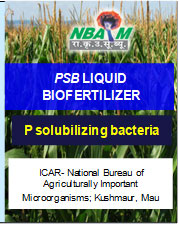 Target crops and delivery system: BioPhos and BioPhos+ can be used for cereals, millets, pulses, vegetables and oil producing commercial crops. Inoculation can be done through seed treatment, root dip for seedlings and soil application for tree plants.
Target crops and delivery system: BioPhos and BioPhos+ can be used for cereals, millets, pulses, vegetables and oil producing commercial crops. Inoculation can be done through seed treatment, root dip for seedlings and soil application for tree plants.
Target agroecological zones (if any): All
Validation and commercialization: The formulations have been validated on maize under AICRP on maize at 22 locations; at UAS, Shimoga besides its validation at ICAR- NBAIM. The technology is commercialized and is on the website of Agrinnovate India Ltd.
4. BioZn
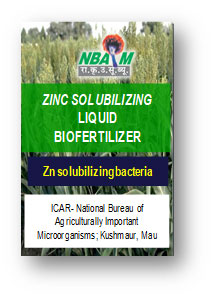 BioZn is A liquid formulation containing highly efficient Zinc solubilizing bacteria (Bacillus endophyticus) that can be used in different types of soils. It has a longer shelf life (12 – 24 months) without loss of microbial populations and properties upon exposure to high temperature.
BioZn is A liquid formulation containing highly efficient Zinc solubilizing bacteria (Bacillus endophyticus) that can be used in different types of soils. It has a longer shelf life (12 – 24 months) without loss of microbial populations and properties upon exposure to high temperature.
Target crops and delivery system: Bio Zn can be used for cereals, millets, pulses, vegetables and oil producing commercial crops. Inoculation can be done through seed treatment, root dip for seedlings and soil application for tree plants.
Target agroecological zones (if any): All
Validation and commercialization: The technology has been validated for wheat at ICAR- IARI and ICAR-NBAIM, Mau and at farmer’s field in Azamgarh district, and on soybean at ICAR- IARI. The technology is commercialized and is on the website of Agrinnovate India Ltd.
5. BioPotash
 A liquid formulation having highly efficient K-solubilizing bacterium Bacillus decolorationis that can be used in different types of soils.
A liquid formulation having highly efficient K-solubilizing bacterium Bacillus decolorationis that can be used in different types of soils.
Target crops and delivery system: Bio Potash can be used for maize, wheat, mustard and potato. Inoculation can be done through seed treatment, root dip for seedlings and soil application for tree plants.
Target agroecological zones (if any): All
Validation and commercialization: The technology has been validated for wheat and maize at ICAR- IARI and ICAR-NBAIM, Mau. The technology is commercialized and is on the website of Agrinnovate India Ltd.
B. For micronutrient fortification
Endophytic microbial inoculants viz. Arthrobacter sulfonivorans and DS-68 Enterococcus hirae DS-163 have been identified and validated to increased the iron concentration in wheat grains. Endophytes Bacillus subtilis DS-178 and Arthrobacter sp. DS-179 have alos been validated for increasing Zn concentration in wheat grains from 28 to 42 mg kg-1. The microbial inoculants are also being tested in Punjab.
C. For management of biotic stress
1. Trichoderma nd Pseudomonas based bioformulations for biocontrol
Three bioformulations of P. fluorescens, T. harzianum and T. viride namely Eco-Pesticide (Talc based bioformulation of Pseudomonas fluorescens); Eco-Green Fungicide (Vermi-based bioformulation of T. viride) and Green Fungicide (Talc based bioformulation of Trichoderma harzianum) respectively, were developed successfully and found effective against a number of soil and seed borne pathogens like Rhizoctonia, Sclerotium, Sclerotinia, Fusarium, Pythium, Ralstonia, Macrophomina, Bipolaris, Phoma, etc.
Green fungicide (Talc based formulation of Trichoderma harzianum) tested in papaya and tomato nursery at farmers’ field in Begusarai, Bihar. No seedling mortality from soil-borne pathogens like Pythium, Phytophthora, Rhizoctonia, etc. as compared to pesticides treatments where 40% mortality was recorded.
2. Bio Pulse: A fly ash based formulation for biocontrol of Fusarium wilt in pulses
A bioformulation of Trichoderma harzianum and Bacillus amyloliquefaciens for control of Fusarium wilt in chickpea. Treatment with formulation could suppress wilt disease by 40% and increased the grain yield by 15% in chickpea on farmers’ field.
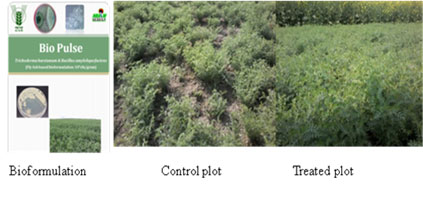
D. For management of abiotic stress
 1. Archaeal formulation for alleviation of drought stress
The Bureau has developed an archeal bioformulation which had been used to grow mustard without any irrigation and wheat with one irrigation. Although yield decreased significantly, but the application of bioformulation could supplement 25-30% yield as compared to un-inoculated control under water stress. Such a formulation can immensely help the farmers to harvest some yield instead of nothing under severe drought conditions. This formulation is being validated throughout the country under AICRP-NSP.
1. Archaeal formulation for alleviation of drought stress
The Bureau has developed an archeal bioformulation which had been used to grow mustard without any irrigation and wheat with one irrigation. Although yield decreased significantly, but the application of bioformulation could supplement 25-30% yield as compared to un-inoculated control under water stress. Such a formulation can immensely help the farmers to harvest some yield instead of nothing under severe drought conditions. This formulation is being validated throughout the country under AICRP-NSP.
Composting
A consortium of four hyper lignocellulolytic fungi (Trichoderma viride, Aspergillus niger, Pleurotus florida and Phanerochaete chrysosporium) recommended for composting of lignocellulosic waste. The consortium has been used for composting of diverse agricultural wastes such as paddy and wheat straw, soybean trash, pearl millet, and maize residues effectively. Mature compost can be obtained within 65-70 days by pit or windrow methods. The technology involves a product in the form of microbial consortium. A carrier based inoculum is available in pack of 1kg and is sufficient for conversion of 1 ton of biomass. Mature compost can be obtained within 70-75 days by pit or windrow methods. By this process N (1-1.5%) and P (0.3-0.5%) enriched compost can be prepared from diverse crop residues within 70-75 days. The application of nutrient enriched compost in soil leads to a significant increase in the soil fertility status, in terms of microbial biomass, N and available P, enhancing the overall physical, chemical and biological health of soil. The supply of 120 kg N, 40 kg P2O5 and 30 kg K2O through application of 10 t compost is an environmental friendly option which can reduce the inputs of chemical fertilizers which are polluting our environment.
Biorpiming techniques for rice
A biopriming technique was developed for the coating of rice seeds with potential cyanobacterial strains (Plectonema boreanum, Anabaena doliolum, Nostoc commune and an equi-proportional mix-culture of these three strains) and field trials for two consecutive years were conducted on eight rice varieties (PR-118, PR-113, MTU-1010, MTU-7029, HUR-105, PB-1, PB-115 and BPT-5204). Viability of the coated seeds and cyanobacteria were found significant even after 18 months of coating. Germination of cyano-coated seeds was 18-20% higher than non-coated seeds. Results on agronomic parameters and biochemical tests were encouraging and coating of seeds with cyanobacteria led to an increase of 5.3 to 7.9% increase in grain yield among different varieties.
Databases/web resources
A. MGR Portal
Microbial Genetic Resource Portal (MGR Portal; www.mgrportal.org.in) gives insight into conservation and management of AIMs at NAIMCC, services offered by NAIMCC (deposition and procurement of genetic material; microbial registration facility), dynamic database search engine, accessibility to catalogue and linkages to important sites is provided. Latest updates on microbial diversity with special reference to India; need for microbial genetic resources conservation; International and National status of conservation of MGR; listings on different federations, societies and networks of Microbial Resource Centres in the world, some leading culture collections in the world and India are provided. A copy right for the database has been obtained (Registration number L-78707/2018 granted on 31/10/2018)
B. MicroVeda
A comprehensive web based system for agriculturally important microbes namely www.microveda.org.inis an unique database having information on the collection of microbes important to agriculture and allied sectors in India, their geo location, characteristics and importance, etc. Also the database attempts to incorporate the Location based searching; MIicrobialDAtabase Search (MIDAS); Knowledge models of microorganisms and trait wise listing of elite microbes at NAIMCC. The database was released by Dr.A.N. Mukhopadhyay, Chairman RAC on 15th February, 2019 during RAC meeting.
Key highlights of the database is
- Unique database defining geo-locations of isolated Agriculturally Important Microorganisms (AIM) strains
- Comprehensive information about AIM w.r.t. characteristics and importance
- Knowledge models and Microbial Database Search (MIDAS) giving concise information
- Trait wise listing of elite microbes at NAIMCC
C. MicroMitra App
An android based bilingual mobile app Micromitra has also been developed which is an initiative of ICAR-NBAIM for farmers. It enlists various microbe based technologies developed at ICAR-NBAIM, Mau, U.P. and gives details on about, crops benefited, advantages, application, dosage, precautions and cost of each technology. An app can be downloaded from www.mgrportal.org.in site as well as play store.
D. Microbial Genetic Resources App
An android based mobile app of MGRportalhas been developed which has search options for general search of microbial accessions by accession number or by name in NAIMCC database; list of microbial accessions in core collection developed based on agriculturally important traits; procurement of microbial cultures from NAIMCC and opinion for query related to microbial germplasm at ICAR-NBAIM, Mau, U.P. An app can be downloaded from www.mgrportal.org.in site as well as play store.
New Methodologies/protocols
1. Conservation technique for cyanobacteria
Developed procedures for storage of cyanobacteria on filter paper strips and silica gel (mesh size 60-120). With filter paper strips, culture was viable for 12 months as evident from chlorophyll content used as a measure of growth. Using silica gels, cyanobacterial cultures were viable till 18 months.
2. Rapid high throughput template preparation method
A novel high throughput method for preparation of PCR ready templates from a wide range of plants has been developed. Following this method, PCR ready templates can be prepared in field conditions without any instrumentation, with basic facilities to boil water. This methodology can be used for molecular detection of pathogens.
3. Modified dual culture technique
In modified methodology of liquid dual culture assay, endophyte bacteria and pathogen are inoculated in bottles broth containing 1:1 ratio of PDB and nutrient broth with sufficient head space and allowed to interact actively for 7 days in the presence of host tissue extract. At the end, inhibition was measured based on biomass accumulated by fungus by the collective effect of any of the mechanisms endophyte might be having. Performing this method for first screening could reduce the chances of losing a potent endophyte from primary population.
4. Nutritional and biotic factors for resurgence of virulence in Ralstonia
Major problem faced with this pathogen is rapid loss of virulence in lab conditions; therefore, the method has been devised to induce virulence. The method precisely uses physical and chemical stimulators for maintaining virulent cultures of Ralstonia solanacearum. The method has been successfully tested on different strains of Ralstonia.
5. Method for high throughput template preparation from fungi
A method for rapid PCR ready template preparation from fungi has been developed. It is high throughput, cost effective, requires very minimal instrumentation and easy to perform. The templates prepared following this method can be used for PCr amplification and subsequent downstream applications.

